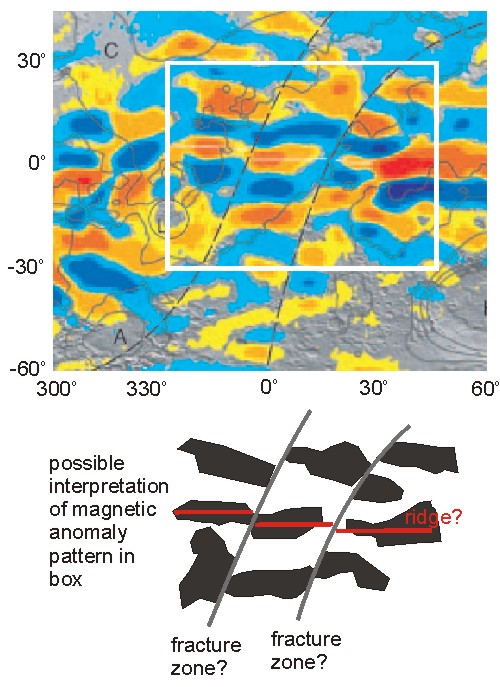The global magnetic anomaly map that I discussed last month has an interplanetary companion, generated from Mars Global Surveyor data by Connerney et al. (click on the image for a larger version):
Modern Mars has no planetary magnetic field to speak of, so the linear anomalies that dominate the southern hemisphere are deviations from a background field of zero, generated by remanent (permanent) magnetisations in the Martian crust. This tells us that a large proportion of the Martian crust formed at a time when Mars did have a strong magnetic field. Furthermore, the fact that we see both positive and negative magnetic anomalies tell us that, just like the Earth’s field, the ancient Martian magnetic field was dynamic, switching between two configurations with opposite polarites.
The stripy nature of the anomaly pattern is extremely interesting, because it looks enticingly similar to the magnetic patterns associated with sea-floor spreading in the Earth’s oceans. It is certainly very tempting to interpret the Martian magnetic stripes as a record of crust being created at a spreading ridge whilst a strong magnetic field was periodically switching polarity, leading to the exciting conclusion that plate tectonics once shaped the Martian surface.
John Connerney and his colleagues at the Goddard Space Flight Centre have sought to test this tantalising hypothesis by looking more carefully at the magnetic anomalies, to see if they truly match the pattern expected from formation at a spreading ridge. If you look at a ridge system on Earth, you’ll see that it’s not just a single long crack in the crust, but rather a number of discrete segments offset by transform faults. This means that the magnetic anomaly patterns mirrored on either side of the ridge are also offset:

If you could spot similar patterns in the anomalies on Mars, this would be strong evidence of origins at a spreading ridge. Connerney et al. reckon that it’s possible to identify a somewhat similar pattern on Meridiani Terra (the equatorial region on the eastern and western edges of the global projection above):

It would be really cool if this was true, but I think that there’s a fair amount of squinting involved in this interpretation. You can certainly pick out a what looks like a symmetrical pattern of stripes on either side of a central ‘ridge’, but my main concern is that the sense of displacement on the ‘fracture zones’ – the direction in which the stripes are being offset – appears to be rather inconsistent. If we are truly looking at ancient fracture zones, then the sense of offset should be the same along the whole structure. Some of this confusion may be due to the complicating influence of remagnetizations related to later meteorite impacts, but I think that the main problem is that the resolution of the data set is not quite up to being interpreted at this scale: the field measurements were made from orbit, which smears out the anomaly pattern and causes useful detail to be lost.
Nonetheless, the existence of a strong, reversing magnetic field is in itself good evidence that once upon a time Mars had a high enough internal temperature to drive a dynamo effect in the core, which is certainly consistent with a vigorously convecting mantle, a thin lithosphere, and – possibly – plate tectonics. Unlike the Earth, however, this geological vigour was short-lived. Since Mars only about 15% of the size of our own planet, it lost its internal heat very quickly, and the Martian lithosphere grew too thick and strong to easily break up into tectonic plates. But brief as it was, this episode probably did more to shape the Martian surface we see today than the billions of years that have followed it have.
Connery et al. (2007). Tectonic implications of Martian crustal magnetism. Proceedings of the National Academy of Sciences 102(42), p14970-975 [doi].




Comments (3)